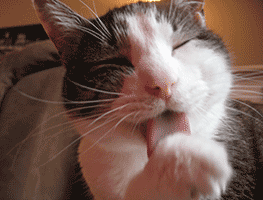Overstimulation with Play in Cats
Cats have innate predatory instincts for survival. Though house cats do not have to pounce, chase, and hunt for their next meal, those predatory behaviors are still practiced during play. They often stalk, chase, bat, pounce, kick, scratch, or bite anything that may resemble prey, such as inanimate objects, toys, and other animals. While these behaviors are normal, they become undesirable when directed toward a person. Overstimulation while playing occurs when a cat redirects play behaviors on a person by biting, scratching, or pouncing on hands, feet, ankles, or other body parts. This can happen during a play session, or when you are not engaging with your cat and they choose to focus on you.
Prevent Rough Play as a Kitten
Cats who have other kittens to play with while growing up learn to inhibit their bite and scratch when wrestling with their littermates – this is how they figure out how rough is too rough. Humans can accidentally reinforce rough play when using their body parts during play. Roughhousing with bare hands may be fun when kittens are small, but it becomes painful and dangerous as your kitten grows up. Using a wand toy during play will still allow you to bond with your kitten without encouraging them to pounce on feet or reach for hands. If the kitten begins to exhibit unwanted rough behavior, end the play session and allow them time to decompress before re-engaging. There may be times when you have to leave the space if the kitten is persistently biting and pouncing on feet, legs, hands, etc.
Know the Warning Signs
The following feline body language can help predict when a cat may be overstimulated:
- • Ears back, or flicking back and forth
- • Tail swishing, thumping, or twitching
- • Dilated pupils, changing focus from toy to person
- • Tensing of muscles
- • Exposing claws
- • Turning head quickly toward your hand, known as a “head flip”
- • Hissing, growling, attempting to bite
If you see any of these warning signs, stop playing, do not attempt to interact, and allow the cat to decompress. If they do not choose to leave, you can toss a treat or toy away from you to redirect. Do not attempt to pick up an overstimulated cat.
Be Prepared
If your cat attacks your feet when you walk by or hides behind objects in order to pounce, carry some small toys such as glitter balls or treats in your pocket so you can toss them away from you. You should ideally use the toys proactively to direct the cat’s attention away from you before they launch at your feet, so they do not get to practice the behavior.
Schedule Play Time
Each day, schedule two or three 10-20 minute interactive play sessions when your cat is most energetic. A wand toy enables you to play with your cat while creating a safe distance between you, and you can make the toys move like prey would. You always want to lure your cat to play and should not stick the toy in their face. By allowing your cat to catch the toy at first, you can build up their confidence and enthusiasm. Note: wand toys should always be stored out of your cat’s reach when the play session is done.
Solo Play
Time You can provide your cat with enrichment by offering a variety of toys for them to play with by themselves. Just like people, cats can get bored with the same toys, so be sure to rotate them every few days to maintain interest. Please see the Enriching Your Cat’s Life page for ideas!
Do Not Punish Your Cat
Never physically or verbally punish your cat for rough play, as it may cause them to escalate their behavior or they may even begin to fear you. It is important to be mindful of cat body language to prevent them from becoming overstimulated and engaging in rough play. If a cat does become overstimulated, stop playing, do not attempt to interact, and allow the cat to decompress.
Getting a Playmate for Your Cat
If you are able to, getting another cat with similar energy and play style as a playmate can be a great option. If you plan on adding another cat into your home, it is best to slowly integrate them into your household, which you can learn more about on our Cat-Cat Introduction page.
It is beneficial to a cat’s mental and physical health to engage in play, but it is important to ensure they are channeling that energy appropriately. If at any time you are in need of support, don’t hesitate to contact the Wisconsin Humane Society behavior department at behavior@wihumane.org or 414-431-6173.

